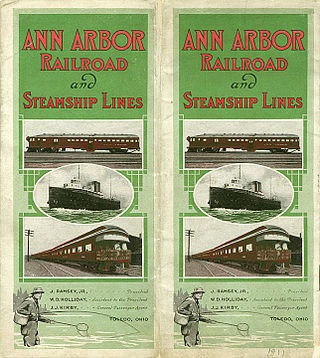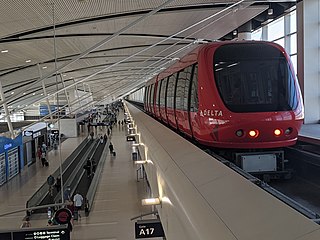The Pere Marquette Railway was a railroad that operated in the Great Lakes region of the United States and southern parts of Ontario in Canada. It had trackage in the states of Michigan, Ohio, Indiana, and the Canadian province of Ontario. Its primary connections included Buffalo; Toledo; and Chicago. The company was named after Jacques Marquette, a French Jesuit missionary who founded Michigan's first European settlement, Sault Ste Marie.
The Lake Shore and Michigan Southern Railway, established in 1833, and sometimes referred to as the Lake Shore, was a major part of the New York Central Railroad's Water Level Route from Buffalo, New York, to Chicago, Illinois, primarily along the south shore of Lake Erie and across northern Indiana. The line's trackage remains a major rail transportation corridor used by Amtrak passenger trains and several freight lines; in 1998, its ownership was split at Cleveland, Ohio, between CSX Transportation to the east and Norfolk Southern Railway in the west.

The Grand Trunk Western Railroad Company was an American subsidiary of the Grand Trunk Railway, later of the Canadian National Railway operating in Michigan, Illinois, Indiana, and Ohio. Since a corporate restructuring in 1971, the railroad has been under CN's subsidiary holding company, the Grand Trunk Corporation. Grand Trunk Western's routes are part of CN's Michigan Division. Its primary mainline between Chicago and Port Huron, Michigan serves as a connection between railroad interchanges in Chicago and rail lines in eastern Canada and the Northeastern United States. The railroad's extensive trackage in Detroit and across southern Michigan has made it an essential link for the automotive industry as a hauler of parts and automobiles from manufacturing plants.

The Ann Arbor Railroad was an American railroad that operated between Toledo, Ohio, and Elberta and Frankfort, Michigan with train ferry operations across Lake Michigan. In 1967 it reported 572 million net ton-miles of revenue freight, including 107 million in "lake transfer service"; that total does not include the 39-mile subsidiary Manistique and Lake Superior Railroad.

The Michigan Central Railroad was originally incorporated in 1846 to establish rail service between Detroit, Michigan, and St. Joseph, Michigan. The railroad later operated in the states of Michigan, Indiana, and Illinois in the United States and the province of Ontario in Canada. After about 1867 the railroad was controlled by the New York Central Railroad, which later became part of Penn Central and then Conrail. After the 1998 Conrail breakup, Norfolk Southern Railway now owns much of the former Michigan Central trackage.

The Great Lakes Central Railroad is an American Class II regional railroad, operating in the state of Michigan. It was originally called the Tuscola and Saginaw Bay Railway, which was formed on August 26, 1977, to operate over former Penn Central lines from Millington to Munger, and from Vassar to Colling. TSBY's name was derived from the three counties it operated in: Tuscola, Saginaw and Bay.
The Chicago and Canada Southern Railway was a planned extension of the Canada Southern Railway west from Grosse Ile, Michigan to Chicago, Illinois. The line was only built to Fayette, Ohio, and was later split between the Detroit, Toledo and Ironton Railway and Lake Shore and Michigan Southern Railway.

The Grand Trunk Milwaukee Car Ferry Company was the Grand Trunk Western Railroad's subsidiary company operating its Lake Michigan railroad car ferry operations between Muskegon, Michigan, and Milwaukee, Wisconsin, from 1905 to 1978. Major railroad companies in Michigan used rail ferry vessels to transport rail cars across Lake Michigan from Michigan's western shore to eastern Wisconsin to avoid rail traffic congestion in Chicago.

The Detroit and Toledo Shore Line Railroad is a historic railroad that operated in northwestern Ohio and southeastern Michigan.
The Lincoln Secondary is a railroad line owned and operated by Conrail in the U.S. state of Michigan as part of its Conrail Shared Assets Operations.

The Ann Arbor Railroad is a Class III Railroad that operates fifty miles of track from Toledo, Ohio, to Osmer, Michigan. The railroad is operated by Watco and is based in Howell, Michigan. Prior to Watco's purchase of the railroad in 2013, the railroad was operated by the Ann Arbor Acquisition Corporation from 1988 to 2013, by the Michigan Interstate Railway from 1977 to 1988, and as a privately owned enterprise prior to 1977.
The following is a brief history of the North American rail system, mainly through major changes to Class I railroads, the largest class by operating revenue.

Transportation in metropolitan Detroit comprises an expansive system of roadways, multiple public transit systems, a major international airport, freight railroads, and ports. Located on the Detroit River along the Great Lakes Waterway, Detroit is a significant city in international trade, with two land crossings to Canada. Three primary Interstate highways serve the region.

The Wabash Railroad was a Class I railroad that operated in the mid-central United States. It served a large area, including track in the states of Ohio, Indiana, Illinois, Iowa, Michigan, and Missouri and the province of Ontario. Its primary connections included Chicago, Illinois; Kansas City, Missouri; Detroit, Michigan; Buffalo, New York; St. Louis, Missouri; and Toledo, Ohio.
The Shore Line Subdivision is a railroad line owned and operated by Grand Trunk Western Railroad (GTW), a subsidiary of Canadian National (CN), in the U.S. state of Michigan and Ohio.
Detroit Terminal Railroad Company was incorporated in the State of Michigan, United States of America, on December 7, 1905, to own railroad track forming a semi-circle around the City of Detroit. It existed as a railroad until it was merged into its parent company, Consolidated Rail Corp., on May 31, 1984.
Wyandotte Terminal Railroad was incorporated in the State of Michigan, United States of America, on September 14, 1904. It ceased operations as a railroad in 1982.

The Ohio Southern Railroad operated between Ironton, Ohio, and Lima, Ohio, from 1893 and 1905. Beginning in 1878 as the narrow gauge Springfield, Jackson and Pomeroy Railroad, it ran from Jackson-Wellston, Jackson County to Springfield, Ohio. The line was converted to a standard gauge by 1880 and renamed the Ohio Southern Railroad in 1881. From Jeffersonville, branch lines were started towards Columbus to the northeast and Cincinnati to the southwest, but never completed. By September 1893, the Ohio Southern had reached north to Lima with a bridge over the Great Miami River at Quincy. At Lima, the freight could link to the Lima Northern Railway for points further north. In 1898, the Lima Northern became the Detroit and Lima Northern Railroad (D&LN). Ohio Southern depots continue to stand in St. Johns, Uniopolis, Jackson Center, Quincy, and Rosewood.

Eugene Zimmerman was an American industrialist and railroad owner. He amassed great wealth as a stockholder or shareholder in John D. Rockefeller's Standard Oil. He used the income from his Standard Oil holdings to invest in railroads.


















